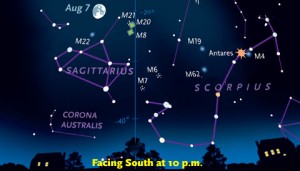Late summer offers the Teapot of Sagittarius and the nearby arc of the Scorpion's Tail in the evening, the Perseid meteor shower, and a spectacular pairing of Venus and Jupiter before dawn.
August will be a busy skywatching month in the evening sky. Two bright planets, Mars and Saturn, are low in the west at dusk. They’re joined by the star Spica. Look for a line of three obvious “stars,” all about the same brightness. The one on the left is Saturn, on the right is Spica, and Mars is in between.

Sky & Telescope diagram
Swing your gaze well to the left, arcing over and past the Saturn-Mars-Spica lineup. Look for a medium-bright star above the southern horizon. That’s Antares, the heart of the constellation Scorpius. Shift your gaze to the left of Antares by a bit more than two fists away. You’re looking for a group of eight medium-bright stars in the shape of a teapot. The handle is on the left and the spout, tipped down a bit, is on the right. Now when astronomers carved up the sky they didn’t call this the Teapot constellation. Instead, you’ve found the main stars of Sagittarius, the Archer. The regions around Sagittarius and Scorpius are rich with star clusters and nebulae.
Meanwhile, if you can manage to rise before the Sun on August 18th, you’ll be rewarded with a view of Venus and Jupiter — the two brightest planets — spectacularly close together not far above the horizon. They’ll be separated by less than ½°. You’ll be able to cover them both with the tip of your little finger on an outstretched arm.
And August is well known for the Perseid meteor shower, which should reach its peak late on Tuesday night, August 12th, and Wednesday morning, the 13th. Unfortunately this year the shower peaks just a couple of days after a full Moon on the 10th. You might see a Perseid or two as early as 9 or 10 p.m., but the shower doesn’t really get going until after 11 or midnight local time, after Perseus rises high in the northeast — and by then the Moon will be up.
And there's even more great skywatching advice in the August issue of Sky & Telescope magazine.
 2
2
Comments
Joann-Coyle
August 19, 2014 at 8:21 am
What happened to the weekly Tony Flanders broadcast, my class needs it?
You must be logged in to post a comment.
John-Innella
August 19, 2014 at 8:14 pm
where is Tony Flanders
You must be logged in to post a comment.
You must be logged in to post a comment.